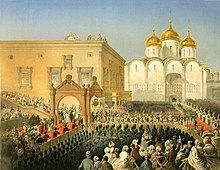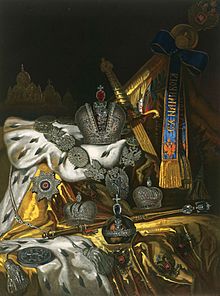Coronation of the Russian monarch
The coronation of the emperor of Russia (generally referred to as the Tsar) from 1547 to 1917, was a highly developed religious ceremony in which they are crowned and invested with regalia, then anointed with chrism and formally blessed by the church to commence his reign.
[5] While months or even years could pass between the initial accession of the sovereign and the performance of this ritual, church policy held that the monarch must be anointed and crowned according to the Orthodox rite to have a successful tenure.
It was equally perceived as conferring a genuine spiritual benefit that mystically wedded sovereign to subjects, bestowing divine authority upon the new ruler.
Sacred and secular, church and state, God and government were all welded together by the coronation service in the person of the anointed Tsar—or so many Russians believed.
Although Russian legend held that it had been given to Vladimir Monomakh by the Byzantine emperor Constantine IX, more modern scholarship assigns an Asian origin to this diadem.
[22] The orb was manufactured in 1762 for Catherine II's coronation, and consisted of a polished hollow ball made from red gold encircled by two rows of diamonds and surmounted by a large sapphire topped by a cross.
[24] Following his entry into the city the new Tsar and his entourage took time to rest and prepare for the following day's ceremony, while heralds in medieval clothing read out special proclamations to "the good people of Our first capital".
[19] Receptions were held for foreign diplomats, the Banner of State was consecrated, and the imperial regalia were brought from the Kremlin Armoury to the throne hall for the procession to the cathedral.
[25] The Tsar was met on the morning of his coronation at the Kremlin Palace's Red Porch, where he took his place beneath a large canopy held by thirty-two Russian generals, with other officers providing additional support.
[26]: 359 The ceremony itself commenced with the singing of Psalm 101, as the Tsar was invited to recite the Niceno-Constantinopolitan Creed according to the Eastern Orthodox usage, without the Filioque clause.
The Metropolitan now read the second prayer, as all inclined their heads: To Thee alone, King of mankind, has he to whom Thou hast entrusted the earthly kingdom bowed his neck with us.
The prayer of the Metropolitan or Patriarch, similar to that of the Patriarch of Constantinople for the Byzantine Emperor, confirmed the imperial supremacy: Most God-fearing, absolute, and mighty Lord, Tsar of all the Russias, this visible and tangible adornment of thy head is an eloquent symbol that thou, as the head of the whole Russian people, art invisibly crowned by the King of kings, Christ, with a most ample blessing, seeing that He bestows upon thee entire authority over His people.
[29]Next the Tsar received his sceptre and orb, given to him by the Metropolitan, who again invoked the Christian Trinity and then recited these words: God-crowned, God-given, God-adorned, most pious Autocrat and great Sovereign, Emperor of All the Russias.
Receive the sceptre and the orb, which are the visible signs of the autocratic power given thee from the Most High over thy people, that thou mayest rule them and order for them the welfare they desire.
The Tsar next placed the Tsaritsa's crown upon his consort's head and the chain of the Order of St. Andrew around her neck, accompanied by a purple mantle, signifying her sharing in his dignity and responsibility for the nation's welfare.
The Russian Orthodox Church had generally opposed the crowning of women prior to Peter's reign, and his decision to introduce this innovation reflected his desire to break with previous tradition and bring Russia more into line with other Western monarchies.
Following this, he rose to his feet, while the presiding bishop and all others present knelt to pray for him on behalf of all the Russian people while the choir sang: "We praise Thee, O God".
After the singing of the Communion hymn, the Tsar gave his sword to an attendant and he and the Tsaritsa ascended the Ambo in front of the Royal Doors of the iconostasis, which were thrown open at that moment.
The Tsar was anointed on his forehead, eyes, nostrils, mouth, ears, breast and both sides of each hand, then he stepped aside to his right and stood in front of the icon of Christ.
After his anointing, but prior to the partaking of Holy Communion, the Tsar recited a coronation oath, in which he swore to preserve the autocracy intact and to rule his realm with justice and fairness.
[33] Russia's last Tsar, Nicholas II, would refer to his coronation oath as one reason he could not give in to demands for a liberal constitution and parliamentary government.
[19] Unlike the Tsar, the Tsaritsa remained outside the Royal Doors and communicated in standard Orthodox lay fashion, receiving both the bread and the wine together on a spoon.
[19] According to biographer Robert K. Massie, the following items were served at Nicholas II's coronation dinner in 1896:[37] Following the banquet, the newly crowned monarchs attended other ceremonies, often including a grand illumination of the Kremlin, fireworks, operas, and various balls.
A special celebration was often organized for the common people of Moscow, usually a day or so after the ceremony at a nearby location where the Tsar and Tsaritsa would attend a feast held for their subjects and inexpensive souvenirs were given away.
The celebration at Nicholas II's coronation in 1896 was marred by the Khodynka Tragedy, when 1,389 persons were trampled to death during a crowd crush prompted by rumors that there were not enough mementos to go around.
Sophia is credited with introducing this and other Byzantine ceremonies and customs, which were adopted by her husband Ivan III and continued under his Muscovite and Russian successors.
[40] Following the death of Tsar Feodor I, Russia descended into a fifteen-year period of political unrest, famine, upheaval and foreign invasion known as the Time of Troubles.
Some of the rulers during this period did not reign long enough or enjoy the political stability necessary to hold a coronation, while one was a foreigner, Wladyslaw IV Vasa of the Polish–Lithuanian Commonwealth.
At the time of Tsar Dmitriy I the False's coronation in 1605, he was unmarried; however, after his marriage to Marina Mniszech of Poland in 1606, his consort was granted her own crowning ceremony upon her arrival in Moscow.
Although no photography was permitted inside the Cathedral of the Dormition during the crowning of Nicholas II or any Russian Tsar, several artistic representations of the ceremony have been made (some of which have been reproduced in this article), and numerous photos and even one motion picture exist of the Tsar's procession, coronation celebrations and other events taking place outside of the church and in surrounding areas of Moscow.















